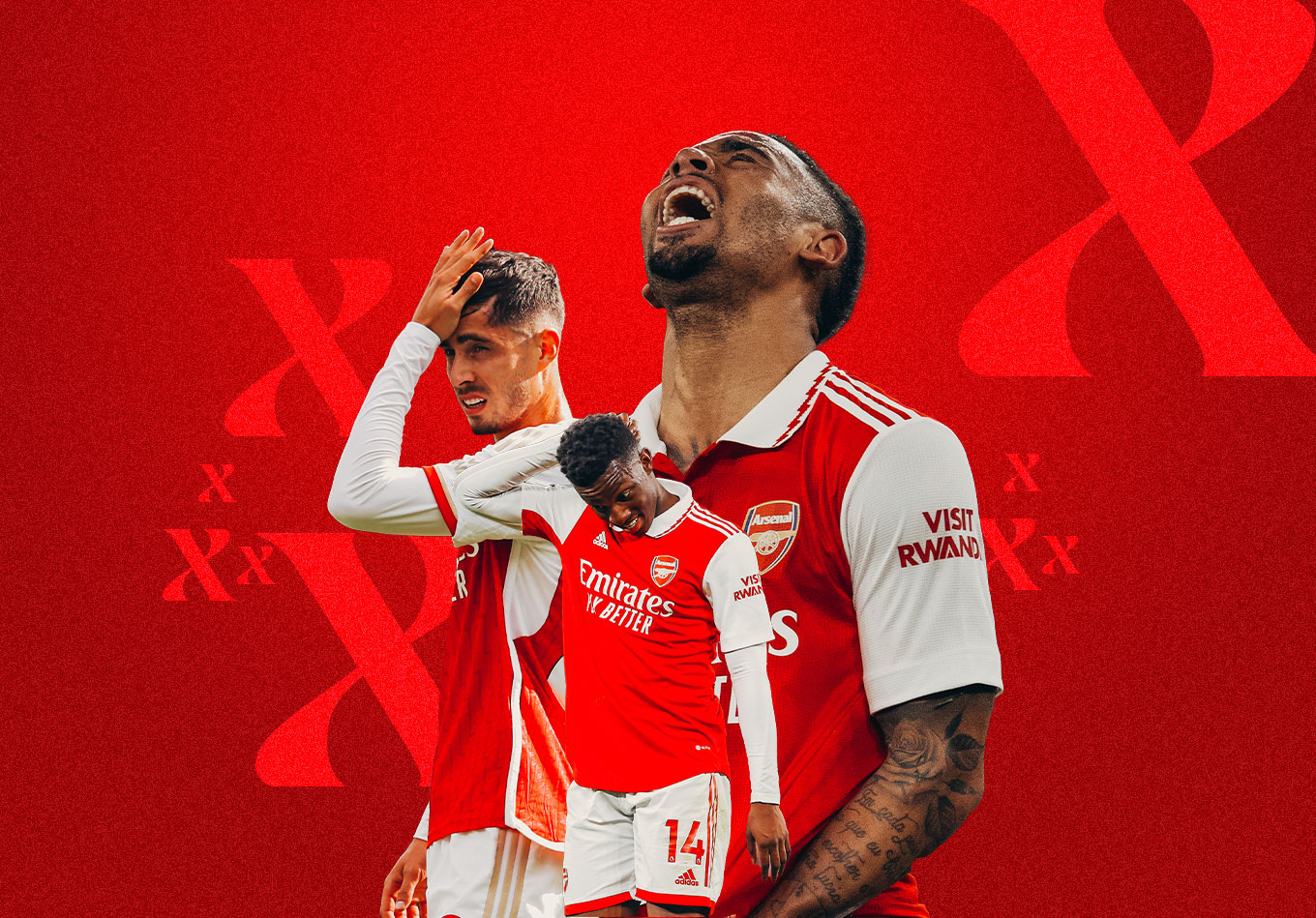The introduction of expected goals to post-match analysis on Match of the Day for the first time in August 2017 confirmed the metric’s place firmly in the mainstream. Now, six years on, expected goals is now widely used and accepted as a decent measure of finishing ability over extended periods.
Top teams make sure to have strikers who can convert their chances at an elite level, fans will use xG as ammo in arguments with friends over their team’s strikers, and Chelsea’s owners have seemingly leant on expected goals and expected points to convince themselves that things aren’t as bad right now as the league table makes them look.
Why, then, does Mikel Arteta not seem to care about the fact that the numbers say his strikers can’t finish?
Okay, that might be an ever-so-mildly hyperbolic way of putting it. The Arsenal manager obviously wants his players to score goals, obviously wants players who can finish and obviously uses data extensively in his work. But it is curious that individual finishing ability doesn’t seem to be a massive priority with many of the players he uses in attacking areas and those he has brought in.
For example, since Gabriel Jesus moved to the Premier League in January 2017, he has the worst record in front of goal of all players, with his 70 goals coming from 85 xG – an unmatched underperformance of 15. The only other players with a negative differential of more than 10 are Neal Maupay (14.9) and a post-Aston-Villa Christian Benteke (12.5).
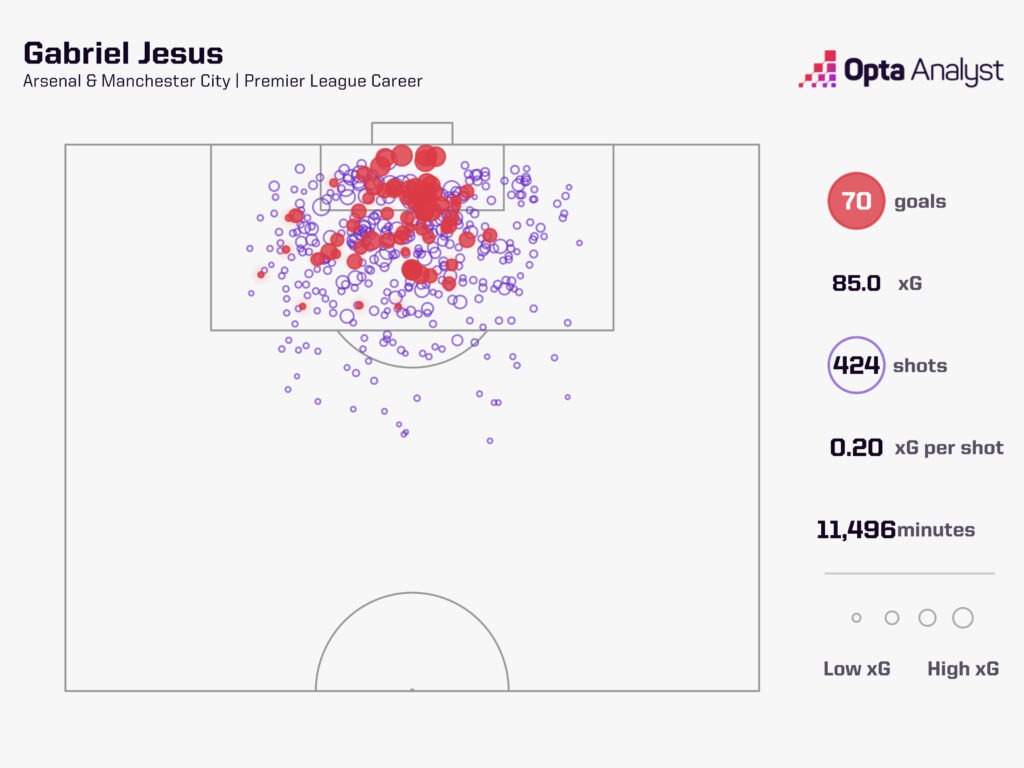
You then don’t have to look far down the list to find another player relevant to our discussion. Kai Havertz sits in 10th place, with his 19 Premier League goals having been scored from 26.6 xG – an underperformance in front of goal of 7.6. His record is slightly better than Timo Werner (8.3) and slightly worse than Patrick Bamford (6.8), neither of whom are exactly known for their finishing ability.
To be fair to Arteta, he didn’t sign Havertz for his finishing. Apart from the Community Shield, in which he played up front, Havertz has played as a left-sided number eight since moving to Arsenal.
But it is worth considering why Arteta was so keen to buy Havertz for a hardly insignificant fee this summer, particularly given he was coming in as a direct replacement for Granit Xhaka, who departed for Bayer Leverkusen having just enjoyed the most prolific season of his career so far, scoring seven Premier League goals in 2022-23 (from 4.8 xG, as it happens).
Havertz had, meanwhile, just had his worst season in front of goal while playing up front for Chelsea, with his six non-penalty goals coming from 10.8 xG. His underperformance of 4.8 was the worst of every player in the Premier League last season, and the fourth worst of every player in Europe’s top five leagues.
Ranking second to Havertz in this regard in the Premier League was Arsenal forward Eddie Nketiah, who underperformed compared to his xG by 4.2. Not a great deal further down the list was Jesus (3.4), in 10th.
In the summer, Arteta had a decision to make over whether to keep Nketiah as his second-choice forward behind Jesus or bring Folarin Balogun back following a successful loan spell on loan in Ligue 1 at Reims. Balogun had scored 21 goals for a mid-table team, and many Arsenal fans preferred the idea of the potentially higher ceiling that Balogun had compared to Nketiah, who hadn’t done enough to convince that he should be the number nine at a club challenging to win the Premier League. Nketiah had just scored four goals from 1,070 minutes – almost 12 matches’ worth of football – for the second-best team in the league, after all.
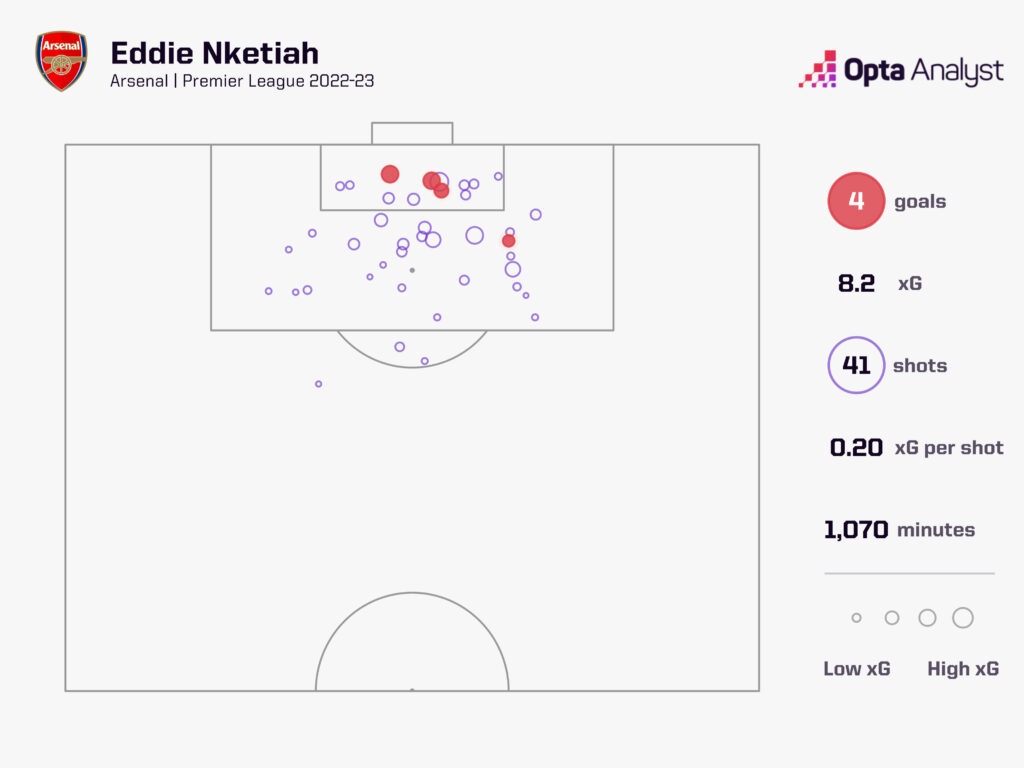
The problem was, funnily enough, Balogun’s finishing. With his goals coming from 26.4 xG, he underperformed compared to his expected goals numbers to a worse extent than any other player in Europe’s top five leagues in 2022-23. He was even worse according to these numbers than the options already at Arsenal.
This is a good point to stop and point out the limitations of using xG over or underperformance with a sample size of a season or less, and even more so when players are as young as Balogun and still learning their craft.
Then 21-year-old Balogun was playing his first top-flight season and doing so for a team expected to struggle in Ligue 1. He was one of only 23 players to score at least 15 non-penalty goals across the top five European leagues last season, and of those players he ranked sixth best for non-penalty xG per 90 (0.62) and non-penalty xG per shot (0.17). And he did it playing for a Reims side that largely attacked on transition.
The hope is that a player like Balogun would eventually improve his finishing with time and experience, and there is every chance that Arteta based his decision more on how he thought Balogun would fare in a possession-dominant team like Arsenal.
At Arsenal last season, the finishing numbers posted by Jesus and Nketiah didn’t really matter. They finished second having led Manchester City in the title race for much of the campaign, scoring 88 goals in total but falling away in the final few weeks. Central midfielder Martin Ødegaard (15) and wingers Gabriel Martinelli (15) and Bukayo Saka (14) all finished among the Premier League’s top 10 scorers. Those three players outperformed their xG for the season by 5.0, 5.9 and 2.7 respectively. And Jesus still got 11 goals, meaning Arsenal had four different players reach double figures for the season. Goals were spread out across the team.
Overall, Arsenal generated 73.2 xG as a team over the course of the campaign; their overperformance of 14.8 was the best in the Premier League and the second best in Europe’s top five leagues, after Bayern Munich (15.7). It wasn’t poor finishing that cost them in the end, but rather injuries and a lack of depth in the squad.
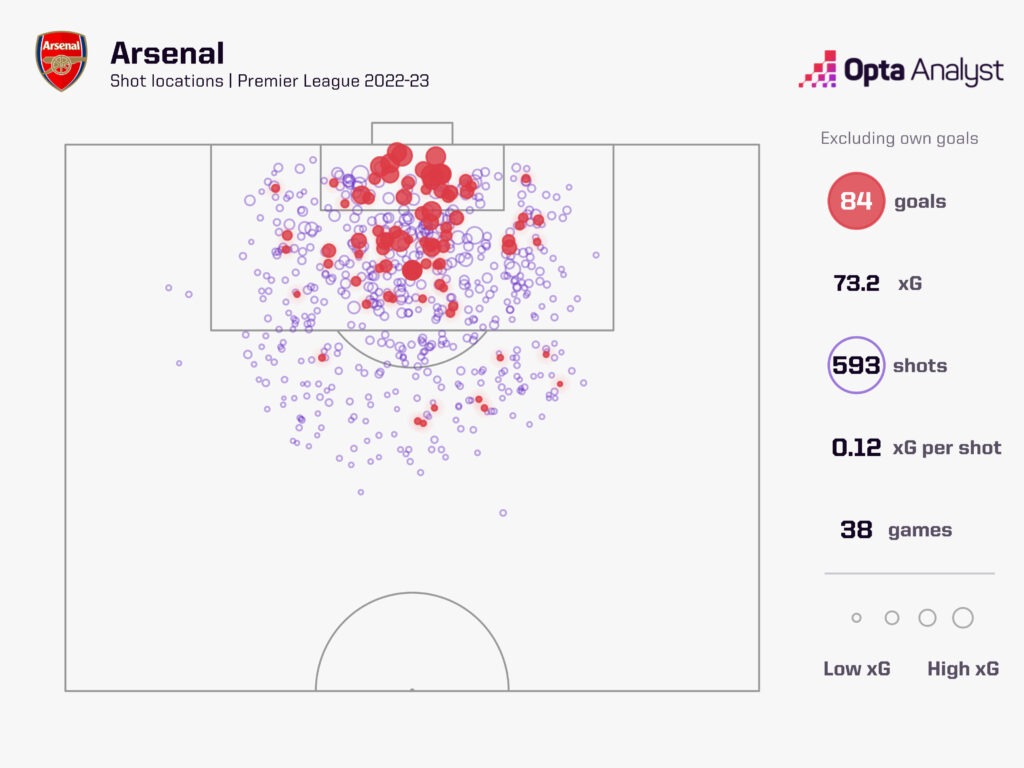
But even so, with Arteta going two-footed into the transfer window this summer, signing £105m Declan Rice, £65m Havertz, £38m Jurriën Timber and loanee David Raya, some might say it was an oversight that he didn’t attempt to address the problems with his team’s finishing. Arteta had clearly decided that Jesus’ other strengths were sufficient.
Jesus came to Arsenal a four-time Premier League winner, a forward who had spent four and a half years learning under Pep Guardiola, who is not only the best in the business, but also a manager who plays a similar brand of football to that which Arteta was trying to promote at Arsenal. Jesus would be able to take on board exactly what Arteta wanted from him – if he didn’t know it already – and a big part of that was how his new manager would ask him to press.
Jesus is one of the best pressing forwards in the world at present. His average since the start of 2021-22 of 0.8 possession regains in the final third per 90 is higher than any other striker to play at least 4,000 Premier League minutes in that time. He also averages 2.5 pressures in the final third resulting in a turnover (actions that put pressure on the ball and lead to someone on the team turning the ball over) per 90 in that time, which puts him fifth among strikers, behind Ché Adams (3.0), Havertz (2.8), Rodrigo (2.7), Michail Antonio (2.6).
You might at this point begin to realise why Havertz was signed. The German is an exceptional presser, who some would argue was played out of position for years up front for Chelsea, having flourished as a number 10 for Bayer Leverkusen. Moving him back into midfield could reduce the goalscoring burden on him and so let him thrive further from goal as a pressing number eight, much like Ødegaard, who is one of the best pressing midfielders in the league.
Reducing the minutes-played threshold on the above search to 2,000 puts Eddie Nketiah top as the best player overall for pressures in the final third leading to a turnover per 90 (4.0).
Arsenal are an exceptional pressing team. They are intense, organised, coordinated and, most of all, smart in their pressing. It was a big part of the reason they were so successful last season. They produced more turnovers within 40m of the opposition’s goal (388) than any other team and scored the joint-most goals from these turnovers (9). It was far from their only route to goal, but it was a crucial one, while many of those 388 high turnovers would have simply allowed them to reset their possession, relieve pressure and attempt to wear the opposition down with their passing game.
For that passing game, a striker who can hold the ball up and comes deep to link play is vital, and Jesus does that brilliantly. He was involved in 5.4 sequences that led to a shot per 90 minutes last season, and 2.4 of those he did not take the shot.
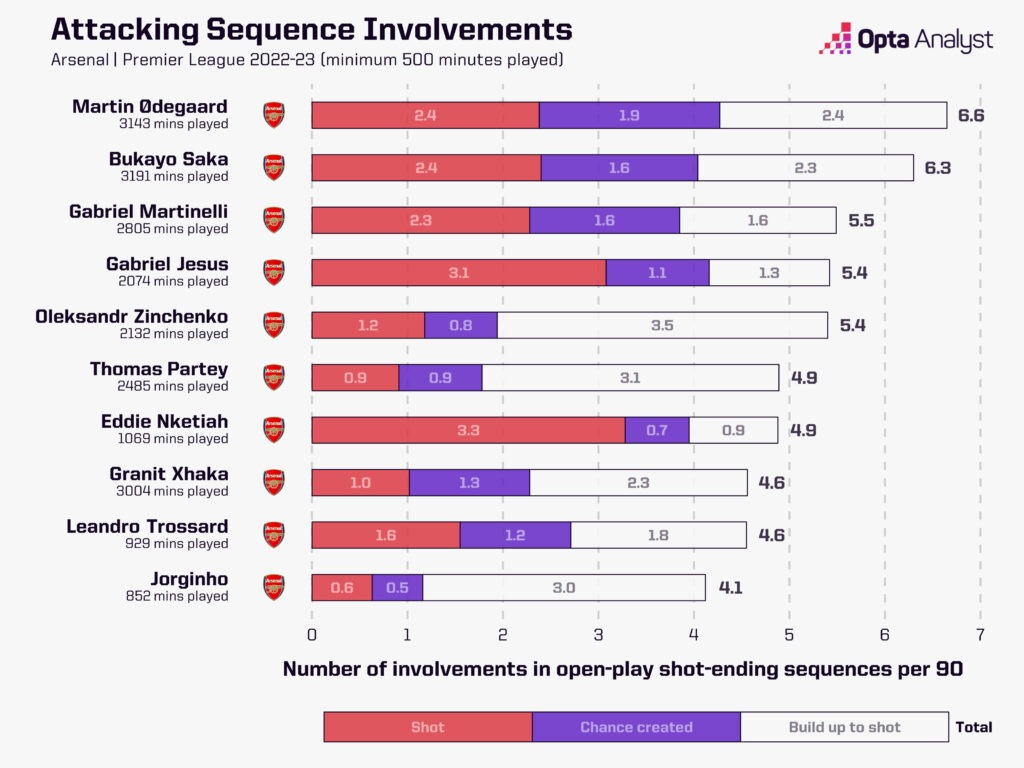
That is where he stands out compared to Nketiah, who is more of a poaching penalty-box striker, though he is improving his all-round game.
With the addition of Havertz and Rice, Arsenal should have become even more effective at suffocating their opponents and winning the ball back high up the pitch. Six games so far in 2023-24 is too small a sample size to draw too many conclusions, particularly because everyone has faced opponents with different playing styles and varying levels of quality, but Arsenal’s 95 pressures in the final third leading to a turnover is the third highest in the Premier League and suggests they are going to continue to play the same way this season. Their signings suggest Arteta is doubling down on that approach. There may be some concern that the focus on their out-of-possession game may have sacrificed too much of their in-possession strengths.
Arsenal do not necessarily attack immediately after winning the ball. They are having a shot from the same move in which they win the ball high up the pitch on average every 5.8 regains, which is the sixth-lowest, suggesting most Premier League teams will focus on scoring straight away more than Arsenal.
But that said, part of the tactic is, of course, to create goalscoring opportunities quickly, and – with the opposition out of shape having lost the ball – hopefully high-quality chances at that.
You didn’t need any data to see how big a chance Jesus had missed after he robbed James Maddison of possession on the edge of the Tottenham box with the score 1-0 to Arsenal in Sunday’s north London derby. Jesus then snatched at his shot and blazed it – a chance worth 0.43 xG for those interested – high over the bar. It’s impossible to know for sure what would have happened had he scored but it would have been very difficult for Spurs to come back from 2-0 down had that shot gone in.
It’s also impossible to know what difference an elite finisher would have made to Arsenal last season. There’s no way of knowing if that kind of player would have made the difference for them in the title race.
That player – a Premier League-ready striker with elite-level finishing and pressing ability to match Jesus – might not exist right now while also being available and gettable for Arsenal.
Some would argue that a club like Arsenal should be able to attract the best of the best, and should have put the money they spent on Havertz, for example, towards an elite finisher.
What difference would a different striker have made so far this season? Well, they might have finished that Jesus chance, but would they have won the ball in the first place?
Enjoy this? Subscribe to our new football newsletter to receive exclusive weekly content. You should also follow our social accounts over on X, Instagram, TikTok and Facebook.
